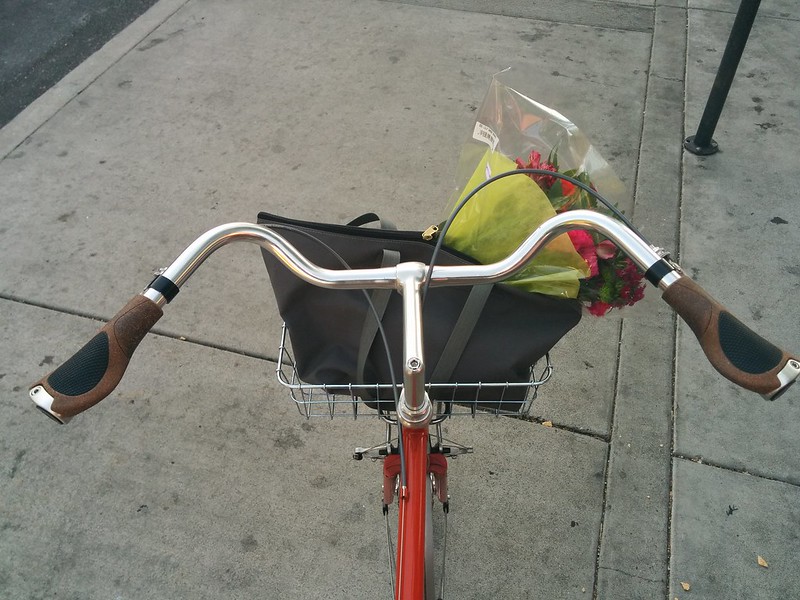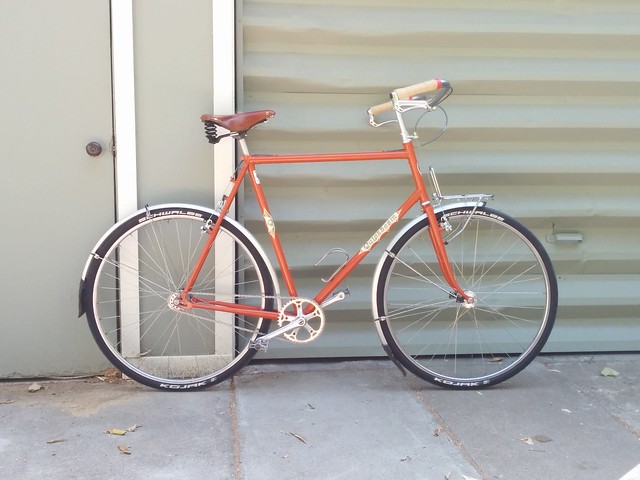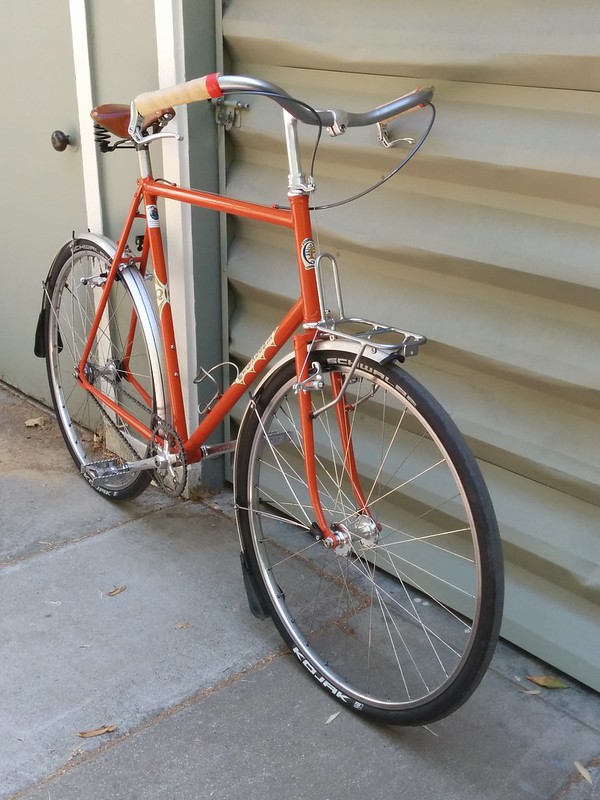With all of the constant changing of bicycle technology and phasing out of old products to make room and excitement for new things, sometimes you discover something really good, that works really well, just as it's getting really hard to find. So it was with me and the Avenir Circa handlebar. This here is my eulogy to what probably seems like a wholly unremarkable handlebar, but is actually something really special. At least to me.
It began life as an OEM spec handlebar on a pretty standard comfort bike, the Raleigh Circa, from which it got its name. As is sometimes the case, Raleigh USA decided to also sell the handlebar aftermarket, through its parts and accessories (P&A) brand Avenir. The Circa handlebar came into my life in 2012, when I started working at a small shop that was just opening in Berkeley. The founder of the shop had previously been a sales rep for Diamondback/Raleigh/Avenir, so their products featured heavily in our early stock, being what he was most familiar with. He had long ridden a Circa bar on his own early 90's Diamondback mountain bike converted to upright Xtracycle cargo bike.
The truth is, the Circa bar would have been an easy sell even if it wasn't totally awesome, because it had that other quality which makes people buy things: it was cheap. We sold it for $24.99. So, when people came into the shop with the old early 90's mountain bike or road bike and sought to address the fact that it was no longer comfortable for the commuting or around-town riding they were doing, the Circa became our go-to suggestion for an upright conversion, and the low cost ensured it was a best-seller. We even included it as a handlebar option for our custom builds of first-generation Xtracycle Edgerunner frames, when we were the only place you could get that bike in California.
Here's the thing: every upright conversion or build I did with a Circa handlebar felt awesome. Just right. That perfect combo of comfortable and sporty that not only made a bike comfortable for around-town riding but fun as well, so you wanted to jump on it rather than get in your car for running errands or going out on the town. And as far as I can remember, every customer who got a Circa bar really liked the way their bike felt.

Furthermore, the design of the Circa bar was really practical for upright conversions. The forward bend before the backsweep meant that the reach often worked out well, without needing a stem swap. There was a convenient flat area next to the stem for lights, bags, basket mounts, or cup holders. The length of the grip area meant that there was plenty of room for shifters, brake levers, standard grips, and even bells, all of which can sometimes get cramped with traditional upright bars. There was even usually room left over at the forward part of the grip, which provided a great second hand position for jamming into the wind or just changing things up. Finally, the generous width (round about 645mm), which really stands out among widely available upright bars, meant that even taller or wide shouldered riders didn't feel cramped out them, which I think is often a stumbling block with upright conversions.
As the bike industry is wont to do, things changed, and Raleigh USA (and hence the Avenir P&A brand) were bought by Accell North America, a wing of a Dutch conglomerate that already own numerous other brands, including other P&A brands. So, in the merger, Avenir as a brand was phased out, and with it the Circa handlebar. Who knows, it probably would have been phased out anyways. When Rob and I saw the writing on the wall, we bought the remaining stock, which didn't amount to much. Knowing there would be no more, I bought a pair for myself, knowing that eventually I'd find a use for them.
When we sold out of our last Circa bars, we started searching for the replacement for the Circa bar. We poured over the catalogs of other P&A brands, searching for bars that seemed to match the dimensions of our beloved Circa. We ordered samples of numerous bars that seems hopeful, but when they arrived we'd take them out of the package, hold them out at arm's length, and just shake our heads. None of them was "just right." None of them was the Circa.
Don't get me wrong. There are tons of great handlebars out there, and I'm sure others have their bar which is "just right" for them. It's no secret that I'm a big fan of Grant Petersen's handlebar designs, and I think our shop might just have been the #1 Bosco bar seller outside of Rivendell. But the Circa bar just seemed to work out so well for so many people, and it's price made it accessible, and it felt great. If I had the ear of Nitto the way that Grant does, it'd be the handlebar shape I'd ask them to make, maybe in their burly CrMo tubing, or the beautiful and strong heat treated aluminum. Yes, it'd be more expensive, but I'd know I could ride that bar for a long, long time.

As for my Circa bar, it's ended up on my Quickbeam. I'm perpetually changing handlebars and stems on that bike, searching for just the right combination, but I seem to keep coming back to the Circa, and the latest setup, with a 130mm Nitto Technomic Deluxe stem and Ergon GC-1 BioKork grips, seems to be the best yet. Like all those bars I sold, it's helping me get closer to "just right."
Here's the thing: every upright conversion or build I did with a Circa handlebar felt awesome. Just right. That perfect combo of comfortable and sporty that not only made a bike comfortable for around-town riding but fun as well, so you wanted to jump on it rather than get in your car for running errands or going out on the town. And as far as I can remember, every customer who got a Circa bar really liked the way their bike felt.

Furthermore, the design of the Circa bar was really practical for upright conversions. The forward bend before the backsweep meant that the reach often worked out well, without needing a stem swap. There was a convenient flat area next to the stem for lights, bags, basket mounts, or cup holders. The length of the grip area meant that there was plenty of room for shifters, brake levers, standard grips, and even bells, all of which can sometimes get cramped with traditional upright bars. There was even usually room left over at the forward part of the grip, which provided a great second hand position for jamming into the wind or just changing things up. Finally, the generous width (round about 645mm), which really stands out among widely available upright bars, meant that even taller or wide shouldered riders didn't feel cramped out them, which I think is often a stumbling block with upright conversions.
As the bike industry is wont to do, things changed, and Raleigh USA (and hence the Avenir P&A brand) were bought by Accell North America, a wing of a Dutch conglomerate that already own numerous other brands, including other P&A brands. So, in the merger, Avenir as a brand was phased out, and with it the Circa handlebar. Who knows, it probably would have been phased out anyways. When Rob and I saw the writing on the wall, we bought the remaining stock, which didn't amount to much. Knowing there would be no more, I bought a pair for myself, knowing that eventually I'd find a use for them.
When we sold out of our last Circa bars, we started searching for the replacement for the Circa bar. We poured over the catalogs of other P&A brands, searching for bars that seemed to match the dimensions of our beloved Circa. We ordered samples of numerous bars that seems hopeful, but when they arrived we'd take them out of the package, hold them out at arm's length, and just shake our heads. None of them was "just right." None of them was the Circa.
Don't get me wrong. There are tons of great handlebars out there, and I'm sure others have their bar which is "just right" for them. It's no secret that I'm a big fan of Grant Petersen's handlebar designs, and I think our shop might just have been the #1 Bosco bar seller outside of Rivendell. But the Circa bar just seemed to work out so well for so many people, and it's price made it accessible, and it felt great. If I had the ear of Nitto the way that Grant does, it'd be the handlebar shape I'd ask them to make, maybe in their burly CrMo tubing, or the beautiful and strong heat treated aluminum. Yes, it'd be more expensive, but I'd know I could ride that bar for a long, long time.

As for my Circa bar, it's ended up on my Quickbeam. I'm perpetually changing handlebars and stems on that bike, searching for just the right combination, but I seem to keep coming back to the Circa, and the latest setup, with a 130mm Nitto Technomic Deluxe stem and Ergon GC-1 BioKork grips, seems to be the best yet. Like all those bars I sold, it's helping me get closer to "just right."



